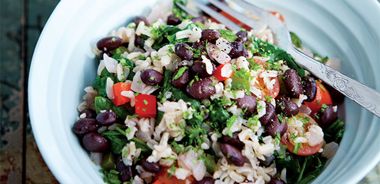Black Bean and Brown Rice Veggie Bowl

From the Middle East to the Caribbean, combinations of beans and rice can be found starring in traditional dishes around the world. Researchers have found when this classic pairing is consumed together, the glycemic response in individuals is reduced more than if rice was eaten alone.
Make this dish your own by adding your favourite veggies and flavourings to it.
2 Tbsp (30 ml) extra-virgin olive oil
1 garlic clove, minced
1 small red onion, diced
1 medium green pepper, seeded and chopped
1 cup (250 mL) cooked long grain brown rice
1 cup (250 mL) cooked black beans
1 cup (250 mL) halved cherry tomatoes
1 cup (250 mL) baby spinach
1/2 cup (125 mL) chopped flat-leaf parsley (optional)
Heat olive oil in skillet over medium heat. Add garlic, onion, and bell pepper; cook until soft.
Remove from heat and toss in remaining ingredients.
Divide between two bowls and serve. Garnish with parsley if desired.
Serves 2.
Each serving contains: 389 calories; 12 g protein; 15 g total fat (2 g sat. fat, 0 g trans fat); 53 g total carbohydrates (6 g sugars, 12 g fibre); 25 mg sodium
Very Berry Oatmeal
A breakfast classic made even healthier with the addition of cinnamon. Research suggests daily consumption of cinnamon may improve blood sugar levels, insulin sensitivity, and blood pressure in those with type 2 diabetes.
1/2 cup (125 mL) sliced frozen strawberries, thawed
1 cup (250 mL) water
1/2 tsp (2 mL) cinnamon
1/2 cup (125 mL) large flake oats
1 Tbsp (15 mL) almond butter
Place thawed strawberries in serving bowl.
In large pot, bring water and cinnamon to a boil. Stir in oats. Reduce heat to a simmer. Allow to cook until desired thickness is reached, stirring occasionally.
Remove from heat and immediately spoon cooked oats over strawberries. Stir in almond butter and garnish with another dash of cinnamon if desired.
Serves 1.
Each serving contains: 446 calories; 16 g protein; 15 g total fat (2 g sat. fat, 0 g trans fat); 66 g total carbohydrates (5 g sugars, 12 g fibre); 6 mg sodium
source: "Cooking with Diabetes Superfoods", alive #373, November 2013




